Awarded Bachelor and Master Theses 2018
The green meadow radiates
Dealing with decommissioned nuclear power plants in Germany. An alternative design using the example of Philippsburg NPP.
Author: Jan Sihler (Master thesis)
Course of studies: Chair of Landscape Architecture and Industrial Landscape
Supervision: Prof. Dr. Udo Weilacher, Dipl.-Ing. Jonas Bellingrodt (TU Munich)

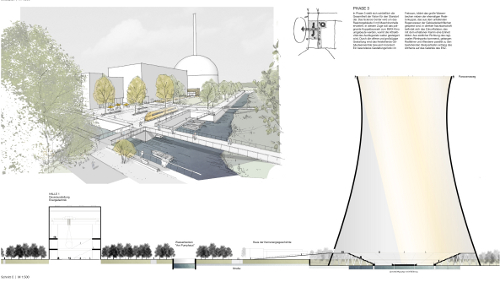
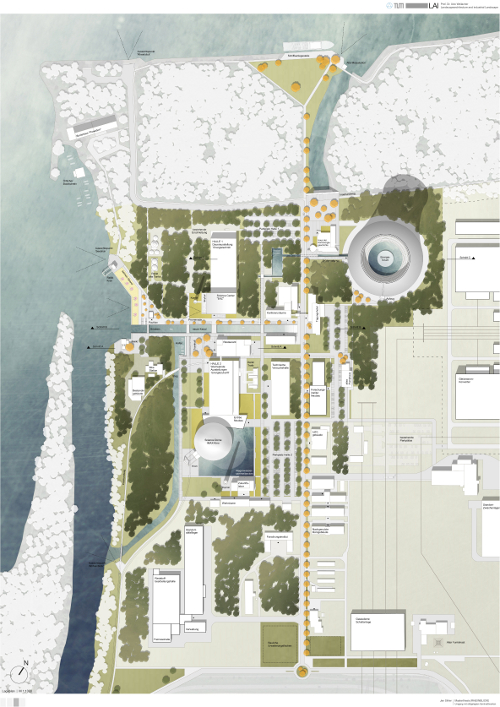
Abstract
The decision to decommission all German nuclear power plants raises the question of the future of the sites. So far there is talk of complete dismantling to greenfield sites. Jan Sihler questions this approach.
The exciting sites have a high development potential, which is derived from the monumental power plant architecture and the scenic location. However, this potential can only unfold if they are given a new meaning. Mental images play a decisive role in this process. A central element of this thesis is the presentation and discussion of the concept of image and its application in spatial planning. The hitherto strongly negative connotation of sites can be transformed through targeted redesign. In addition to their function as landmarks, the sites represent important cultural monuments of a socially controversial development phase in German history.
Using the example of the Philippsburg nuclear power plant, the design (RH)EINBLICKE shows how the special scenic location of the site on the Rhine and the nuclear power plant as a cultural monument can be transformed into an attractive building block in the overarching Rhine Park North. The redesign of the site creates a new spatial image that is capable of achieving the desired image change. The Philippsburg case study demonstrates the potential of alternative development concepts that urgently need to be worked out in order to give the social and political discussion of the issue an appropriately broader basis. Nuclear power plants are areas of potential that we should not misjudge but actively use.
Justification for the award
In his final thesis, Jan Sihler addresses the unpleasant but urgent question of how a sustainable and yet design-appealing and functionally sensible reuse of former nuclear power plants can look. The work describes all the existing plants in Germany, some of which are being dismantled or have been partially dismantled.
It is a great merit to show an overview of the spatial planning situation of these plants in a comparative analysis. In addition, the work vividly shows the impact of these plants as a spatial image. His exemplary design for the Philippsburg site shows the dismantling and development of the site in several phases up to the year 2050 and thus forms a trend-setting, innovative and sustainable approach to handing over the relics of the energy industry to future generations.
Deusenberg in Dortmund - video visualization
Author: David Karg (Bachelor thesis)
Course of studies: Landscape architecture, focus on open space planning
Supervision: Prof. U. Stock-Gruber, Lecturer special tasks Matthias Thoma (University of Applied Sciences Weihenstephan-Triesdorf)
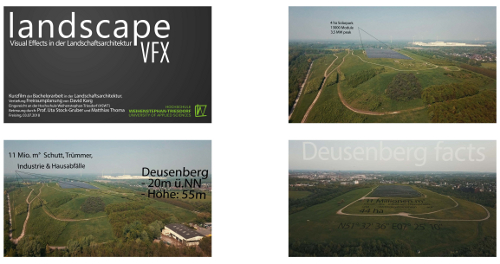
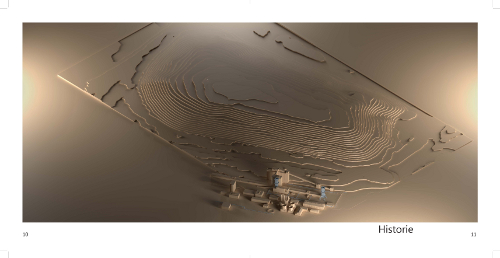

Abstract
David Karg first developed a design for a former garbage mountain in the north of Dortmund, which should make it experienceable as a landmark and usable as an open space: thus a differentiated path network leads the visitors to different vantage points, which focus on special objects and areas in the wider surroundings.
The open space design forms the basis of a video visualization. Mr. Karg analyzed the current relief of the mountain by means of a drone flight. Subsequently, the design was visualized as a film.
Justification of the award
On the one hand, Mr. Karg succeeded in subtly integrating the planned structures into the special spatial conditions without changing the original character of the site too much. On the other hand, the work corresponds to the trend of developing open-space designs as spatial sequences and also visualizing them in accordance with this goal.
Especially in the field of participation in the context of design projects in public space, the work is purposeful, since it optimally informs laypersons about planned future spatial constellations up to the materiality.
AllBeton - Living in the green
AllBeton - Living in the green. The way is the goal.
Author: Charlotte Lehner (Bachelor thesis)
Course of studies: Chair of Landscape Architecture and Public Space
Supervision: Prof. Regine Keller, M.A. Andrea Mühlmann (TU Munich)

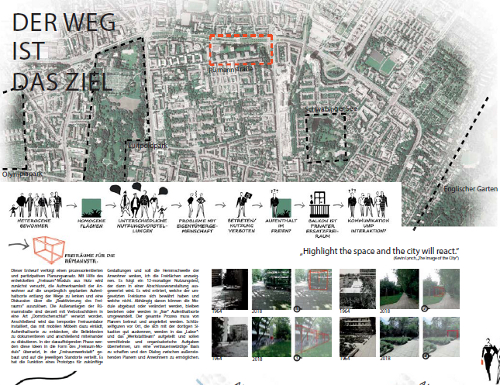
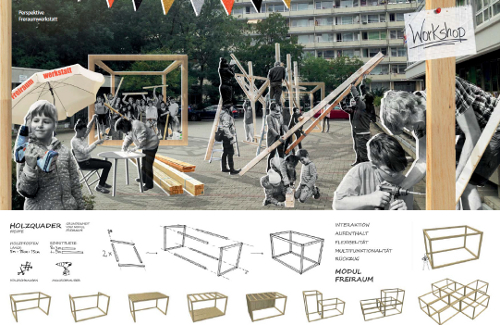
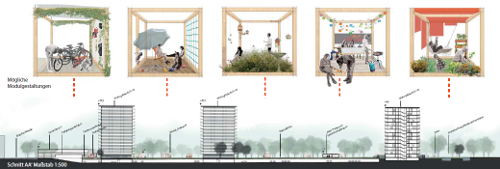
Abstract
This bachelor thesis deals with the development of an open space concept for a point housing estate in Munich, which was built in the post-war period and is owned by an owners' association. The aim is to contribute to a sustainable improvement of the quality of living. On the one hand, the challenge is to respect the history and the existing buildings. On the other hand, it should meet contemporary usage requirements.
Based on selected reference projects, a participatory and process-oriented approach was developed for this purpose. The design describes a planning process in three phases. In a development process lasting several months, with the participation of residents and local entrepreneurs and with the help of selective interventions, an attempt is to be made to reactivate places to stay and to sensitize users to the topic of open space appropriation in the long term. The work provides a strategic approach on how to initiate and implement improvement processes in a timely and low-conflict manner in residential areas built in the post-war period and occupied by owner-occupiers.
Spontaneous vegetation as a design tool of the future
Spontaneous vegetation as a design tool of the future. Landscape Park Riem - Developments. Tendencies. Solutions.
Author: Marc Weißhaar (Bachelor thesis)
Course of studies: Landscape architecture, focus on open space planning
Supervision: Prof. Dr. Swantje Duthweiler (Weihenstephan-Triesdorf University of Applied Sciences)
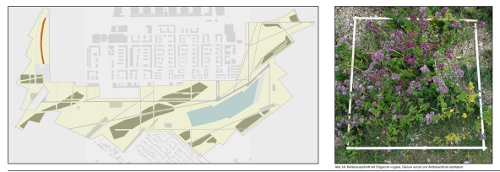

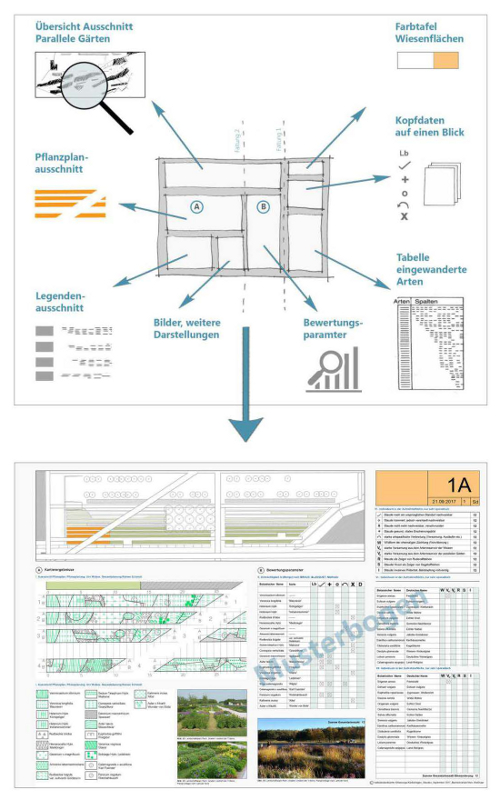
Abstract
Plantings at garden shows are often intended for a short period of time, but they have a lot of potential for a more sustainable, long-term effect. The decision to maintain or deconstruct plantings usually depends on the expected maintenance costs. But how does species potential change in relation to different maintenance strategies? So far, there is only little scientific knowledge about this.
Using the example of the Landscape Park Riem, the dynamic processes of the former garden show perennial plantings, meadow seeding and woody plantings from 2005 to summer/autumn 2017 are traced using extensive species mapping and compared to a monitoring of the maintenance measures. The analysis focuses on the characteristics of the species used with regard to their longevity, individual dispersal behaviour and special dynamics (including invasive potential), but also the role of spontaneously occurring vegetation.
Where does the diasporic potential of the introduced species originate from? Do spatial transitions play a role with regard to the distribution of species? Can insights into spontaneous vegetation be found as a means of shaping the future? Are there still possibilities to support or stage this process in terms of design? Based on the results of the analysis, three scenarios represent the different developments of the park in the future.
Justification of the award
Marc Weißhaar's bachelor thesis takes up a topic that has not been investigated much so far: How can the longevity of plantations be supported and secured by species shifts with immigrating wild species? Where do new potentials and limits lie here, how must care be adapted to this?
In his bachelor thesis, Marc Weißhaar analyses the dynamics of former garden show plantations in depth and in an outstanding graphic presentation up to the present day. The work shows excellent quality in content and presentation and is characterized by an analytical and a future-oriented design-care-concentration part. As a result, Marc Weißhaar's bachelor thesis is decidedly innovative and very significant for future plantings in public green spaces.
The Young Talent Award 2018 was kindly supported by Riede Landschaftsarchitektur.
- Latitude: 0
- Longitude: 0



